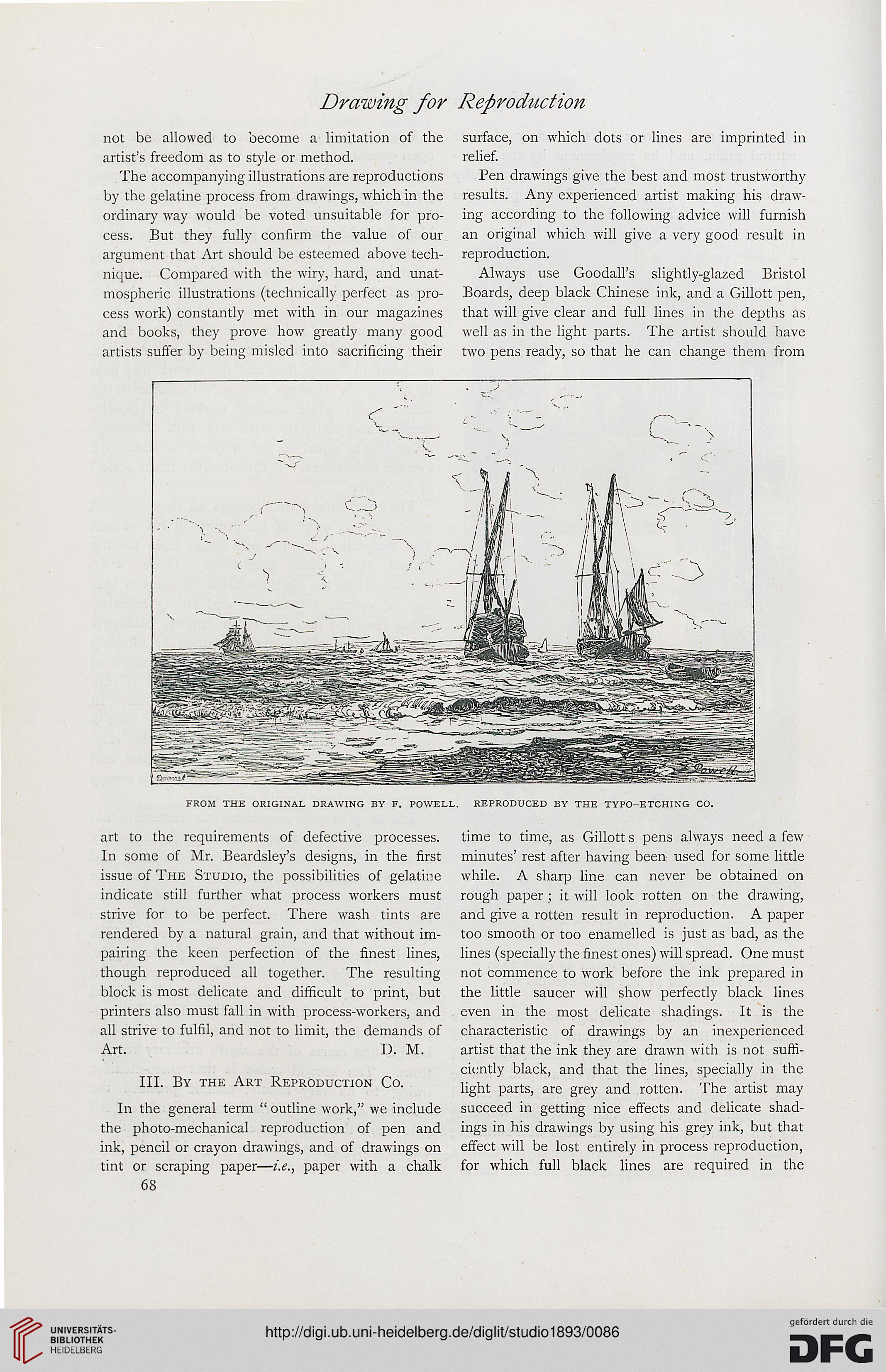Drawing for Reproduction
not be allowed to become a limitation of the surface, on which dots or lines are imprinted in
artist's freedom as to style or method. relief.
The accompanying illustrations are reproductions Pen drawings give the best and most trustworthy
by the gelatine process from drawings, which in the results. Any experienced artist making his draw-
ordinary way would be voted unsuitable for pro- ing according to the following advice will furnish
cess. But they fully confirm the value of our an original which will give a very good result in
argument that Art should be esteemed above tech- reproduction.
nique. Compared with the wiry, hard, and unat- Always use Goodall's slightly-glazed Bristol
mospheric illustrations (technically perfect as pro- Boards, deep black Chinese ink, and a Gillott pen,
cess work) constantly met with in our magazines that will give clear and full lines in the depths as
and books, they prove how greatly many good well as in the light parts. The artist should have
artists suffer by being misled into sacrificing their two pens ready, so that he can change them from
FROM THE ORIGINAL DRAWING BY F. POWELL. REPRODUCED BY THE TYPO—ETCHING CO.
art to the requirements of defective processes.
In some of Mr. Beardsley's designs, in the first
issue of The Studio, the possibilities of gelatine
indicate still further what process workers must
strive for to be perfect. There wash tints are
rendered by a natural grain, and that without im-
pairing the keen perfection of the finest lines,
though reproduced all together. The resulting
block is most delicate and difficult to print, but
printers also must fall in with process-workers, and
all strive to fulfil, and not to limit, the demands of
Art. D. M.
III. By the Art Reproduction Co.
In the general term " outline work," we include
the photo-mechanical reproduction of pen and
ink, pencil or crayon drawings, and of drawings on
tint or scraping paper—i.e., paper with a chalk
68
time to time, as Gillott s pens always need a few
minutes' rest after having been used for some little
while. A sharp line can never be obtained on
rough paper; it will look rotten on the drawing,
and give a rotten result in reproduction. A paper
too smooth or too enamelled is just as bad, as the
lines (specially the finest ones) will spread. One must
not commence to work before the ink prepared in
the little saucer will show perfectly black lines
even in the most delicate shadings. It is the
characteristic of drawings by an inexperienced
artist that the ink they are drawn with is not suffi-
ciently black, and that the lines, specially in the
light parts, are grey and rotten. The artist may
succeed in getting nice effects and delicate shad-
ings in his drawings by using his grey ink, but that
effect will be lost entirely in process reproduction,
for which full black lines are required in the
not be allowed to become a limitation of the surface, on which dots or lines are imprinted in
artist's freedom as to style or method. relief.
The accompanying illustrations are reproductions Pen drawings give the best and most trustworthy
by the gelatine process from drawings, which in the results. Any experienced artist making his draw-
ordinary way would be voted unsuitable for pro- ing according to the following advice will furnish
cess. But they fully confirm the value of our an original which will give a very good result in
argument that Art should be esteemed above tech- reproduction.
nique. Compared with the wiry, hard, and unat- Always use Goodall's slightly-glazed Bristol
mospheric illustrations (technically perfect as pro- Boards, deep black Chinese ink, and a Gillott pen,
cess work) constantly met with in our magazines that will give clear and full lines in the depths as
and books, they prove how greatly many good well as in the light parts. The artist should have
artists suffer by being misled into sacrificing their two pens ready, so that he can change them from
FROM THE ORIGINAL DRAWING BY F. POWELL. REPRODUCED BY THE TYPO—ETCHING CO.
art to the requirements of defective processes.
In some of Mr. Beardsley's designs, in the first
issue of The Studio, the possibilities of gelatine
indicate still further what process workers must
strive for to be perfect. There wash tints are
rendered by a natural grain, and that without im-
pairing the keen perfection of the finest lines,
though reproduced all together. The resulting
block is most delicate and difficult to print, but
printers also must fall in with process-workers, and
all strive to fulfil, and not to limit, the demands of
Art. D. M.
III. By the Art Reproduction Co.
In the general term " outline work," we include
the photo-mechanical reproduction of pen and
ink, pencil or crayon drawings, and of drawings on
tint or scraping paper—i.e., paper with a chalk
68
time to time, as Gillott s pens always need a few
minutes' rest after having been used for some little
while. A sharp line can never be obtained on
rough paper; it will look rotten on the drawing,
and give a rotten result in reproduction. A paper
too smooth or too enamelled is just as bad, as the
lines (specially the finest ones) will spread. One must
not commence to work before the ink prepared in
the little saucer will show perfectly black lines
even in the most delicate shadings. It is the
characteristic of drawings by an inexperienced
artist that the ink they are drawn with is not suffi-
ciently black, and that the lines, specially in the
light parts, are grey and rotten. The artist may
succeed in getting nice effects and delicate shad-
ings in his drawings by using his grey ink, but that
effect will be lost entirely in process reproduction,
for which full black lines are required in the




